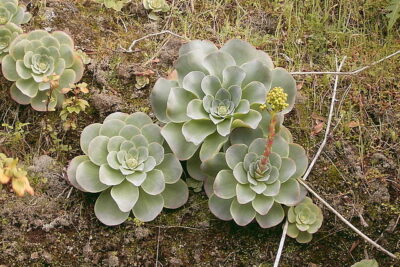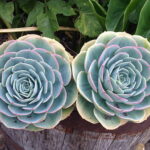
Indoor Succulent Care: Expert Tips for Blue Succulents

Indoor gardening has become increasingly popular in recent years as people seek to bring nature into their homes. One particular type of plant that has gained significant attention is succulents. These unique plants are known for their ability to store water in their leaves, making them low-maintenance and perfect for indoor settings. One variety of succulents that has captivated many plant enthusiasts is the blue succulents. With their striking blue hues, these plants add a touch of uniqueness and vibrancy to any indoor space.
We will delve into the world of indoor succulent care, specifically focusing on blue succulents. We will provide expert tips and advice on how to properly care for these plants, ensuring their health and longevity. Topics that will be covered include the ideal lighting and temperature conditions, watering techniques, soil requirements, and common issues and solutions related to blue succulent care. Whether you are a seasoned succulent enthusiast or a beginner looking to add some blue succulents to your indoor garden, this article will provide you with the essential knowledge and guidance to keep your plants thriving.
- Provide adequate sunlight for blue succulents by placing them near a south-facing window
- Use a well-draining succulent soil mix to prevent overwatering and root rot
- Water blue succulents sparingly, allowing the soil to dry out between waterings
- Avoid watering the leaves of blue succulents to prevent rot and fungal diseases
- Fertilize blue succulents with a balanced succulent fertilizer during the growing season
- Protect blue succulents from extreme temperatures by keeping them in a controlled indoor environment
- Monitor for signs of pests, such as mealybugs or aphids, and treat them promptly if detected
- Rotate blue succulents regularly to ensure even growth and prevent leaning towards the light source
- Trim and prune blue succulents as needed to maintain their desired shape and prevent overcrowding
- Repot blue succulents every 1-2 years to refresh the soil and promote healthy growth
- Frequently Asked Questions
Provide adequate sunlight for blue succulents by placing them near a south-facing window
When it comes to indoor succulent care, providing adequate sunlight is crucial for the health and vibrant color of blue succulents. These unique plants require bright light to maintain their blue hues and prevent them from turning green.
To ensure your blue succulents receive the right amount of sunlight, it's best to place them near a south-facing window. South-facing windows usually receive the most sunlight throughout the day, making them an ideal spot for light-loving succulents.
However, it's important to note that direct sunlight can be too intense for blue succulents, especially during the hot summer months. To protect them from scorching, you can use sheer curtains or blinds to filter the sunlight and provide a more diffused light source.
If you don't have access to a south-facing window, you can also consider using artificial grow lights. LED grow lights are an excellent alternative for indoor succulent care, as they provide the necessary light spectrum for optimal growth and color development.
Remember to rotate your blue succulents every few weeks to ensure even exposure to sunlight. This will prevent them from leaning towards the light source and promote symmetrical growth.
 Indoor or Outdoor: Maximizing Succulent Growth for Optimal Results
Indoor or Outdoor: Maximizing Succulent Growth for Optimal ResultsOverall, providing adequate sunlight for your blue succulents is essential to keep their vibrant color and promote healthy growth. Whether you have access to a south-facing window or rely on artificial grow lights, ensuring they receive enough light will help them thrive indoors.
Use a well-draining succulent soil mix to prevent overwatering and root rot
When it comes to caring for blue succulents, one of the most important factors to consider is the type of soil you use. Blue succulents, like other succulent varieties, require a well-draining soil mix to prevent overwatering and root rot.
A well-draining soil mix ensures that excess water can easily escape from the roots, preventing them from sitting in moisture for too long. This is especially crucial for blue succulents, as their unique coloration is often a result of a waxy coating that helps them retain water. If the roots are constantly saturated, they can become susceptible to rot, leading to the decline of the plant.
To create a well-draining soil mix for your blue succulents, start with a commercial cactus or succulent soil mix as a base. These mixes are specifically formulated to provide excellent drainage while retaining enough moisture for succulents to thrive. You can find these soil mixes at most garden centers or online.
Additionally, you can enhance the drainage of the soil mix by adding perlite or pumice. These lightweight materials help create air pockets in the soil, allowing excess water to easily drain away. Aim to add about 30% perlite or pumice to your soil mix for optimal drainage.
Remember, when repotting your blue succulents, always choose a pot with drainage holes to further facilitate water drainage. If you're unable to find a pot with drainage holes that suits your aesthetic preferences, you can also create drainage by adding a layer of small rocks or pebbles at the bottom of the pot before adding the soil mix.
Using a well-draining succulent soil mix is crucial for preventing overwatering and root rot in blue succulents. By providing the proper drainage, you can ensure that your blue succulents stay healthy, vibrant, and continue to showcase their unique blue hues.
 Growing Curly Jade Succulents Indoors: Tips and Advice
Growing Curly Jade Succulents Indoors: Tips and AdviceWater blue succulents sparingly, allowing the soil to dry out between waterings
When it comes to caring for blue succulents, one of the most important things to keep in mind is their watering needs. These unique and beautiful plants are known for their ability to store water in their leaves, making them highly drought-tolerant.
It's crucial to water blue succulents sparingly, as overwatering can lead to root rot and other issues. To ensure the health and longevity of your blue succulents, allow the soil to dry out completely between waterings. This might mean watering them only once every two to three weeks, depending on the climate and humidity levels in your home.
When watering your blue succulents, it's best to use the "soak and dry" method. This involves thoroughly watering the soil until it's completely saturated and allowing any excess water to drain out. Avoid letting your succulents sit in standing water, as this can cause root rot.
Additionally, it's important to note that blue succulents are more prone to root rot than other succulent varieties. Therefore, it's crucial to use well-draining soil specifically formulated for succulents. You can also add perlite or pumice to the soil mixture to improve drainage.
Signs of overwatering in blue succulents
- Yellowing or mushy leaves: If the leaves of your blue succulent start to turn yellow or feel mushy to the touch, it's a clear indication of overwatering. This is a sign that the roots are being suffocated and are starting to rot.
- Wilting or drooping: Overwatered blue succulents may also start to appear wilted or droopy, even though the soil is moist. This is because the roots are unable to absorb water properly, leading to dehydration.
- Mold or fungus growth: Excessive moisture can create the perfect environment for mold and fungus to thrive. If you notice any mold or fungus growing on the soil surface or the leaves of your blue succulents, it's a clear sign of overwatering.
If you notice any of these signs, it's important to adjust your watering routine immediately. Allow the soil to dry out completely before watering again, and make sure to remove any affected leaves or roots to prevent further damage.
Remember, when it comes to blue succulents, less is more when it comes to watering. By following these expert tips and closely monitoring the moisture levels, you can ensure that your blue succulents thrive and maintain their stunning color.
 Can a Mother of Millions Succulent Thrive Indoors?
Can a Mother of Millions Succulent Thrive Indoors?Avoid watering the leaves of blue succulents to prevent rot and fungal diseases
When it comes to caring for blue succulents, one of the most important things to keep in mind is to avoid watering the leaves. Unlike other plants, succulents have adapted to survive in arid conditions by storing water in their leaves and stems. However, excessive moisture on their leaves can lead to rot and fungal diseases.
Watering your blue succulents directly on the leaves can create a damp environment, which is the perfect breeding ground for fungi. To prevent this, it is best to water your succulents at the base, near the soil. This allows the roots to absorb the water they need without putting the leaves at risk.
Additionally, it is crucial to ensure that your succulent's pot has proper drainage. Succulents prefer well-draining soil and pots with drainage holes. These holes allow excess water to escape, preventing water from pooling around the roots and potentially causing root rot.
Another expert tip for avoiding leaf rot in blue succulents is to water them sparingly. These plants are adapted to survive in arid conditions, so they do not require frequent watering. Overwatering can lead to waterlogged soil and ultimately damage the roots of your succulent.
It is recommended to water blue succulents only when the soil is completely dry. You can check the moisture level by sticking your finger about an inch into the soil. If it feels dry, it's time to water your succulent. Remember, it's better to underwater than overwater when it comes to succulents.
To summarize, when caring for blue succulents:
- Avoid watering the leaves to prevent rot and fungal diseases
- Water at the base, near the soil
- Ensure proper drainage in the pot
- Water sparingly and only when the soil is completely dry
By following these expert tips, you can ensure that your blue succulents thrive and maintain their vibrant color.
 Can Red Rose Succulents Thrive Indoors?
Can Red Rose Succulents Thrive Indoors?Fertilize blue succulents with a balanced succulent fertilizer during the growing season
When it comes to indoor succulent care, one important aspect to consider is fertilization. Blue succulents, in particular, require a balanced succulent fertilizer during the growing season to maintain their vibrant color and overall health.
Choosing the right fertilizer is crucial to provide the necessary nutrients for your blue succulents. Look for a fertilizer specifically formulated for succulents, as it will have the appropriate balance of nutrients and micronutrients required for their optimal growth.
During the growing season, which typically spans from spring to early fall, it is recommended to fertilize your blue succulents once a month. This regular fertilization helps to replenish the nutrients that may have been depleted from the soil and assists in supporting their active growth.
When applying the fertilizer, make sure to dilute it according to the instructions provided by the manufacturer. It is essential not to over-fertilize your blue succulents as it can lead to nutrient burn and damage the plants. Diluting the fertilizer ensures that you are providing them with just the right amount of nutrients they need.
In addition to the regular fertilization, it is essential to monitor your blue succulents for any signs of nutrient deficiencies or excesses. If you notice yellowing leaves, stunted growth, or discoloration, it may indicate an imbalance in nutrients. Adjusting the fertilizer application accordingly can help rectify these issues.
Remember to always water your blue succulents before fertilizing them. This helps to prevent any potential root burn that may occur if the fertilizer is applied to dry soil. Watering the plants before fertilization ensures that the nutrients are evenly distributed and absorbed by the roots.
By following these expert tips for fertilizing your blue succulents, you can ensure they receive the necessary nutrients for their vibrant color and overall well-being.
 Can Crassula Flapjack Succulent Thrive and Flourish Indoors?
Can Crassula Flapjack Succulent Thrive and Flourish Indoors?Protect blue succulents from extreme temperatures by keeping them in a controlled indoor environment
Blue succulents are unique and eye-catching, but they require special care to maintain their vibrant color. One of the key factors in ensuring the health and longevity of blue succulents is protecting them from extreme temperatures. Unlike some other succulents that can tolerate a wide range of temperatures, blue succulents are more sensitive and require a stable indoor environment.
Extreme heat or cold can cause the blue pigmentation in succulents to fade or become dull. To prevent this from happening, it is crucial to keep your blue succulents in a controlled indoor environment where the temperature remains relatively stable.
Choose the right location
When selecting a location for your blue succulents, it is essential to consider their temperature preferences. Ideally, place them in a room that maintains a temperature between 60°F (15°C) and 80°F (27°C). Avoid placing them in areas with drafts or near heating or cooling vents, as sudden temperature fluctuations can be detrimental to their health.
Additionally, make sure your blue succulents receive adequate sunlight. Most succulents thrive in bright light conditions, but direct sunlight for extended periods can cause sunburn and damage the foliage. Aim for a balance by placing your blue succulents near a sunny window but ensuring they are not exposed to intense sunlight for more than a few hours a day.
Provide insulation during extreme weather
During extreme weather conditions, such as heatwaves or cold snaps, it is crucial to provide insulation to protect your blue succulents. You can achieve this by using insulating materials like bubble wrap or horticultural fleece to cover the pots or create a mini greenhouse effect around the plants.
For hot weather, the insulation will shield the succulents from excessive heat and prevent sunburn. In cold weather, it will help retain warmth and protect the plants from frost and freezing temperatures.
 Can Succulents Thrive Outdoors with Minimal Care?
Can Succulents Thrive Outdoors with Minimal Care?Monitor humidity levels
Humidity plays a significant role in the overall health of your blue succulents. While most succulents prefer low humidity levels, blue succulents can tolerate slightly higher humidity. Aim for a humidity level between 40% and 60% to provide the ideal environment for your blue succulents.
If you live in an area with high humidity, consider using a dehumidifier or placing a tray of water-absorbent material, such as pebbles or perlite, near the plants. This will help absorb excess moisture and prevent issues like root rot.
On the other hand, if you live in a dry climate, you can increase humidity around your blue succulents by misting them with water occasionally or using a humidifier in the room.
Conclusion
By keeping your blue succulents in a controlled indoor environment, you can protect them from extreme temperatures and ensure their vibrant blue color remains intact. Remember to choose the right location, provide insulation during extreme weather, and monitor humidity levels to create the perfect environment for your blue succulents to thrive.
Monitor for signs of pests, such as mealybugs or aphids, and treat them promptly if detected
When it comes to caring for blue succulents, it's important to keep a watchful eye for signs of pests. Mealybugs and aphids are common culprits that can infest indoor succulents. These tiny insects can cause damage to the plant by feeding on its sap, leading to weakened growth and even death if left untreated.
To ensure the health and longevity of your blue succulents, regularly inspect the leaves and stems for any signs of these pests. Look for tiny white, cotton-like clusters or small, green insects that can often be found on the undersides of the leaves or in the crevices between the plant's stems. These are telltale signs of a mealybug or aphid infestation.
 Indoor Succulent Gardening: Best Tall Succulents for Thriving Indoors
Indoor Succulent Gardening: Best Tall Succulents for Thriving IndoorsIf you detect any signs of pests, it's crucial to take action promptly. One effective way to treat mealybugs and aphids is by using a strong stream of water to wash them off the plant. You can also try wiping them away with a cotton swab dipped in rubbing alcohol.
For more severe infestations, consider using an organic insecticidal soap or neem oil. These natural remedies are safe for succulents and can help eliminate pests without causing harm to the plant.
Provide the right amount of light and temperature
Proper lighting and temperature are key factors in the care of blue succulents. These unique plants thrive in bright, indirect sunlight, so it's crucial to provide them with the right amount of light.
When placing your indoor succulents, choose a location near a window that receives indirect sunlight for several hours a day. Avoid placing them in direct sunlight, as this can cause their leaves to become scorched and damaged.
In terms of temperature, blue succulents prefer moderate to warm conditions. They can tolerate a wide range of temperatures but do best in a range between 65°F and 80°F (18°C - 27°C). Avoid exposing them to extreme cold or heat, as this can stress the plants and lead to poor growth.
During the winter months, it's essential to provide adequate warmth to your blue succulents. If your home tends to get chilly, consider using a heating mat or placing the plants near a heat source to ensure they stay within their preferred temperature range.
Watering and soil requirements
Proper watering and soil conditions are crucial for the health of blue succulents. These plants have unique water requirements compared to other houseplants.
 Succulents: Indoor or Outdoor Plants?
Succulents: Indoor or Outdoor Plants?First, it's important to choose the right type of soil for your succulents. Opt for a well-draining soil mix specifically formulated for cacti and succulents. This type of soil allows excess water to drain quickly, preventing root rot and other moisture-related issues.
When it comes to watering, blue succulents have a preference for infrequent but deep watering. Allow the soil to dry out completely between waterings, and then thoroughly saturate the soil until water drains out of the bottom of the pot.
During the winter months, when succulents enter a period of dormancy, reduce watering frequency to prevent the soil from staying excessively damp. Overwatering can lead to root rot and other fungal diseases, so it's essential to strike the right balance.
Remember, it's better to underwater than to overwater your blue succulents. These plants are adapted to survive in arid conditions and can withstand short periods of drought.
- Monitor the soil moisture levels regularly
- Adjust watering frequency based on the season and plant's needs
- Do not let the succulents sit in standing water
- Use a well-draining soil mix specifically formulated for succulents
By following these watering and soil guidelines, you can ensure that your blue succulents stay healthy and vibrant.
Encourage proper airflow and humidity
Adequate airflow and humidity levels are essential for the overall health and well-being of blue succulents. While these plants are drought-tolerant, they still benefit from a moderate level of humidity to thrive.
To promote proper airflow, avoid overcrowding your succulents. Give each plant enough space to allow for air circulation, which helps prevent the development of fungal diseases and pests.
 Growing Trunked Succulents Indoors: A Guide
Growing Trunked Succulents Indoors: A GuideIf you live in a dry climate, you can increase humidity levels around your blue succulents by using a humidifier or placing a tray of water near the plants. As the water evaporates, it adds moisture to the surrounding air.
However, it's important not to overdo it with humidity, as excessive moisture can lead to rot and other issues. Aim for a humidity level of around 40-50% for optimal growth.
Additionally, ensure that your succulents are not placed near drafts, as these can cause temperature fluctuations and drying of the leaves.
With the right balance of airflow and humidity, you can create a favorable environment for your blue succulents to thrive.
Conclusion:
Proper care and attention are essential to ensure the health and vibrancy of blue succulents. By monitoring for pests, providing the right amount of light and temperature, maintaining proper watering and soil conditions, and encouraging proper airflow and humidity, you can create an ideal environment for your indoor succulents to flourish.
Remember to observe your plants closely and make adjustments as needed. With these expert tips, you'll be well-equipped to care for your blue succulents and enjoy their stunning beauty for years to come.
 Choosing Low-Light Succulents: A Guide to Thriving Indoors
Choosing Low-Light Succulents: A Guide to Thriving IndoorsRotate blue succulents regularly to ensure even growth and prevent leaning towards the light source
Blue succulents are a stunning addition to any indoor garden. Their unique coloration adds a cool and refreshing touch to your space. However, to ensure that your blue succulents thrive and maintain their vibrant hue, it is important to provide them with proper care and attention.
1. Find the right spot for your blue succulents
When it comes to indoor succulent care, one of the most crucial factors to consider is their exposure to light. Blue succulents, just like their green counterparts, require bright indirect light to thrive. Place them near a window where they can receive ample sunlight, but make sure to avoid placing them in direct sunlight, as it can scorch their leaves.
2. Rotate your blue succulents regularly
To ensure even growth and prevent your blue succulents from leaning towards the light source, it is important to rotate them regularly. Succulents have a natural tendency to lean towards the direction of light, which can result in uneven growth and a lopsided appearance. By rotating your blue succulents every few weeks, you can promote balanced growth and maintain their symmetrical shape.
3. Water your blue succulents sparingly
Succulents, including blue succulents, are adapted to survive in arid conditions. Therefore, overwatering is one of the most common mistakes made in succulent care. Water your blue succulents sparingly, allowing the soil to dry out completely between waterings. Be sure to use a well-draining potting mix and a pot with drainage holes to prevent waterlogged roots.
4. Use a balanced fertilizer
While succulents are generally low-maintenance plants, they can benefit from occasional feeding. Use a balanced fertilizer specifically formulated for succulents, and follow the instructions on the packaging for the recommended dosage and frequency. Over-fertilizing can lead to burnt leaves or even damage the plant, so it's important to stick to the recommended guidelines.
5. Keep an eye out for pests
Even though succulents are relatively resistant to pests, they can still fall victim to common indoor pests like mealybugs and spider mites. Regularly inspect your blue succulents for signs of infestation, such as webbing, discolored leaves, or sticky residue. If you notice any pests, remove them manually or use an organic insecticidal soap to control the infestation.
By following these expert tips for indoor succulent care, you can ensure that your blue succulents remain healthy and vibrant. Remember, each succulent has its own unique care requirements, so it's always important to research the specific needs of your blue succulents and adjust your care routine accordingly.
Trim and prune blue succulents as needed to maintain their desired shape and prevent overcrowding
When it comes to caring for blue succulents, one important task is to regularly trim and prune them as needed. This not only helps maintain their desired shape and appearance but also prevents overcrowding.
Trimming and pruning blue succulents can be done using a pair of clean, sharp scissors or pruning shears. Before you start, make sure to sanitize your tools to avoid the spread of any potential diseases or pests.
Here are some expert tips to guide you through the process:
- Remove dead or yellowing leaves: As blue succulents grow, it is natural for some leaves to wither or turn yellow. These leaves no longer contribute to the plant's health and aesthetics. Gently pluck them off to keep your succulent looking vibrant and healthy.
- Prune overcrowded stems: Over time, blue succulents can produce new stems and offsets, leading to overcrowding. This can hinder the overall growth and health of the plant. Identify any crowded or overlapping stems and carefully trim them back to provide ample space for each stem to flourish.
- Shape your succulent: If you have a specific shape in mind for your blue succulent, pruning can help you achieve it. Determine the desired shape, and then trim the succulent accordingly. Whether you prefer a compact rosette or a cascading form, selective pruning can help you achieve the look you desire.
- Prune leggy growth: Sometimes, blue succulents may experience leggy growth, where the stems stretch out excessively. This can happen when the plant is not receiving enough sunlight. To correct this, trim back the leggy stems to encourage the growth of new, compact growth.
Remember to take your time and be patient while trimming and pruning your blue succulents. It's essential to avoid excessive cutting or removing too many leaves at once, as this can cause stress to the plant. Regular maintenance and care will ensure healthy and vibrant blue succulents that will bring beauty to your indoor space.
Repot blue succulents every 1-2 years to refresh the soil and promote healthy growth
When it comes to caring for blue succulents, one important aspect to keep in mind is the need for repotting. Repotting your blue succulents every 1-2 years is a crucial step in ensuring their overall health and vitality.
By repotting, you are refreshing the soil and providing your succulents with a fresh start. Over time, the soil in the pot can become compacted and depleted of nutrients, which can hinder the growth and development of your blue succulents.
Here are some expert tips to guide you through the repotting process:
- Choose the right time: The best time to repot your blue succulents is during the spring or early summer months when they are actively growing. Avoid repotting during the dormant winter season.
- Select an appropriate container: Opt for a container that has drainage holes to prevent water from accumulating and causing root rot. Additionally, ensure that the new pot is slightly larger than the current one to allow room for growth.
- Prepare the new soil: Use a well-draining succulent potting mix or create your own by combining equal parts of regular potting soil, perlite, and coarse sand. This mixture will provide the right balance of moisture retention and drainage.
- Gently remove the succulent: Carefully remove the blue succulent from its current pot by gently loosening the roots. Be cautious not to damage the delicate roots or stems.
- Inspect the roots: Take this opportunity to examine the roots for any signs of rot or damage. Trim away any unhealthy or dead roots using clean and sterilized pruning shears.
- Place in the new pot: Position the blue succulent in the center of the new pot and fill the remaining space with the prepared succulent potting mix. Gently press down the soil to secure the plant in place.
- Allow time to adjust: After repotting, it is essential to give your blue succulent some time to adjust to its new environment. Place it in a bright location with indirect sunlight and refrain from watering for the first week.
- Maintain regular care: Once your blue succulent has settled into its new pot, continue providing it with the proper care it needs. This includes watering sparingly, providing sufficient sunlight, and avoiding overfertilizing.
By following these expert tips and repotting your blue succulents every 1-2 years, you can ensure their well-being and enjoy their striking beauty indoors.
Frequently Asked Questions
1. Can blue succulents be grown indoors?
Yes, blue succulents can be grown indoors. However, they require bright, indirect sunlight to maintain their vibrant color.
2. How often should I water my blue succulents?
Water your blue succulents only when the top inch of soil is completely dry. Overwatering can cause root rot and damage the plant.
3. Do blue succulents need any special care compared to other succulent varieties?
Blue succulents require the same basic care as other succulent varieties. However, they may need slightly more sunlight to maintain their color.
4. Can I propagate blue succulents?
Yes, blue succulents can be propagated through stem or leaf cuttings. Make sure to allow the cuttings to callous over before planting them in well-draining soil.
If you want to read more articles similar to Indoor Succulent Care: Expert Tips for Blue Succulents, you can visit the Indoor and Outdoor Care category.






You Must Read